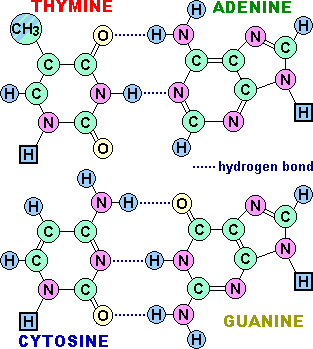The Structure of DNA
DNA (Deoxyribonucleic Acid) is composed of two Polynucleotide Strands (the polymers of nucleotides), which form what looks like a ladder. The Nitrogenous Bases in DNA store the instructions for making polypeptide chains, essentially coding for every feature of the entire organism.
The two polynucleotide strands run ‘antiparallel’ to each other, with Nitrogenous Bases projecting inwards. The term ‘antiparallel’ means that the strands run in opposite directions, parallel to one another. The antiparallel strands twist in a complete DNA structure, forming a Double Helix.
The strands are held together by Hydrogen Bonds between the Nitrogenous Bases that are opposite each other. Bases bonded together are termed ‘paired’, and are very specific as to which Base they will join to. A Purine will only pair with a Pyrimidine. Not only that, but the Adenine Purine will only pair with the Thymine Pyrimidine (A-T), and the Guanine Purine will only pair with the Cytosine Pyrimidine (G-C). These base pairings are termed Complementary Base Pairings.

- The reason that Purines will only bond with Pyrimidines is that Purines are larger molecules (composed of a double ring structure), so in order to ensure that the polynucleotide strands are equally spaced apart, the larger Bases must pair with the smaller bases. The root for the specific Complementary Base Pairings is the number of Hydrogen bonding sites available. Adenine and Thymine have two sites each, whereas Guanine and Cytosine have three sites each.

Replication
DNA must be copied when cells divide. This is called Replication. This process takes place during Interphase.
The Double Helix is untwisted and the antiparallel strands are unzipped - the Hydrogen bonds between the bases are broken. Free floating Nucleotides join with the exposed Nitrogenous Bases, forming Hydrogen bonds - this part of the ‘reason’ for Complementary Base Pairing. The new Nucleotides are bonded together by the enzyme DNA Polymerase, which form complete strands opposite the original strands. The two new DNA molecules form Double Helices.
The new molecules contain one strand of the original an one new strand, and so this type of replication is called Semi-Conservative Replication.
